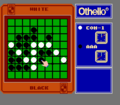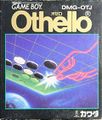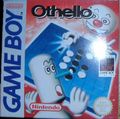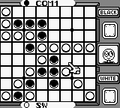Othello is a strategy board game played by two parties on an eight-by-eight square grid with pieces that have two distinct sides. Pieces typically appear coin-like, but with a light and a dark face, each side representing one player. The object of the game is to make your pieces constitute a majority of the pieces on the board at the end of the game, by turning over as many of your opponent's pieces as possible.
The modern version of the game is based on the game Reversi that was invented around 1880 by two Englishmen, Lewis Waterman and John W. Mollett, and gained considerable popularity in England at the end of the 19th century. The modern rule set, now universally accepted, originated in Mito, Ibaraki, Japan in the 1970s; the game was renamed Othello, and was registered as a trademark by the Japanese game company Tsukuda Original. The name is a reference to the Shakespearean play Othello, the Moor of Venice. The game enjoyed much success in Japan, partially due to its similar appearance to Go.
When electronic gaming became an increasingly popular phenomenon throughout the world, and especially in Japan, Tsukuda Original sought to release a computer version of the game that could be bought by families and played on a television set. Tsukuda Original purchased the rights to utilize Sega's SG-1000 technology (the precursor to the Sega Master System), and created their own console which included the game of Othello built into the system.
For more information on how to play Othello, and the strategies behind it, please see the Othello guide on Wikibooks.
Sega SG-1000
The result of Tsukuda Original's console development was the Othello Multivision. It had the ability to play every existing Sega SG-1000 cartridge, as well as games that were developed by Tsukuda Original for the system. Only a few such games were developed, including Q*Bert and Guzzler. The system included the game of Othello built into the system, which could be accessed by turning the game on without any cartridge plugged in. In 1985, Sega licensed the right from Tsukuda Original, to publish the game on a cartridge that could be played by owners of the original SG-1000. The graphics were touched up, but the program is essentially the same as the version found on the Othello Multivision.
-
SG-1000 box art
-
SG-1000 screen
Famicom and NES
Publisher Kawada sought to release a version of Othello on the popular Nintendo Famicom. They bought the rights to publish the game, and first released it on disk media for the Famicom Disk System in October of 1986. However, only one month passed before Kawada published the game in cartridge format for the Famicom in November. This move makes Othello the fastest game to appear in both disk format and cartridge format in the shortest amount of time. Two years later, Acclaim purchased the rights from Kawada to publish the game in the United States for the NES. All three versions are identical.
-
Famicom Disk System cover
-
Famicom box art
-
NES box art
-
NES screen
Game Boy
In 1990, Kawada published the game for Nintendo's original Game Boy handheld system. The game play is unaltered from the Famicom release, but new "opponents" are introduced. The player can select from four different computer opponents of various skill levels. Nintendo decided to publish the game as a first-party title in Europe, but this version of the game was never released in the United States.
-
Japanese Game Boy box art
-
European Game Boy box art
-
Game Boy screen








